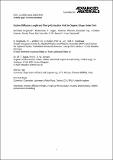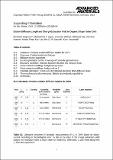Files in this item
Exciton diffusion length and charge extraction yield in organic bilayer solar cells
Item metadata
| dc.contributor.author | Siegmund, Bernhard | |
| dc.contributor.author | Sajjad, Muhammad Tariq | |
| dc.contributor.author | Widmer, Johannes | |
| dc.contributor.author | Ray, Debdutta | |
| dc.contributor.author | Koerner, Christian | |
| dc.contributor.author | Riede, Moritz | |
| dc.contributor.author | Leo, Karl | |
| dc.contributor.author | Samuel, Ifor David William | |
| dc.contributor.author | Vandewal, Koen | |
| dc.date.accessioned | 2018-02-02T00:31:41Z | |
| dc.date.available | 2018-02-02T00:31:41Z | |
| dc.date.issued | 2017-03-28 | |
| dc.identifier | 248655828 | |
| dc.identifier | 7d26afb6-d702-4190-a9a6-7ce03b5d416f | |
| dc.identifier | 85011423395 | |
| dc.identifier | 000396998800003 | |
| dc.identifier.citation | Siegmund , B , Sajjad , M T , Widmer , J , Ray , D , Koerner , C , Riede , M , Leo , K , Samuel , I D W & Vandewal , K 2017 , ' Exciton diffusion length and charge extraction yield in organic bilayer solar cells ' , Advanced Materials , vol. 29 , no. 12 , 1604424 . https://doi.org/10.1002/adma.201604424 | en |
| dc.identifier.issn | 0935-9648 | |
| dc.identifier.uri | https://hdl.handle.net/10023/12651 | |
| dc.description | The authors thank the German BMBF for funding within the scope of the projects InnoProfile 2.2 (03IPT602X) and MEDOS (03EK3503A) as well as the European Commission within the scope of the Career Integration Grant (FP7, MSCA, 630864). I.D.W.S. and M.T.S. acknowledge support from the European Research Council (grant number 321305) and from EPSRC (grant number EP/L017008/1). I.D.W.S. also acknowledges a Royal Society Wolfson Research Merit Award. K.L. is a fellow of the Canadian Institute for Advanced Research (CIFAR). The research data supporting this publication can be accessed at https://doi.org/10.17630/af263bfb-620c-40a8-9929-86658e5187d3 | en |
| dc.description.abstract | A method for resolving the diffusion length of excitons and the extraction yield of charge carriers is presented based on the performance of organic bilayer solar cells and careful modeling. The technique uses a simultaneous variation of the absorber thickness and the excitation wavelength. Rigorously differing solar cell structures as well as independent photoluminescence quenching measurements give consistent results. | |
| dc.format.extent | 5 | |
| dc.format.extent | 885428 | |
| dc.format.extent | 770320 | |
| dc.language.iso | eng | |
| dc.relation.ispartof | Advanced Materials | en |
| dc.subject | Exciton diffusion length | en |
| dc.subject | Charge carrier extraction | en |
| dc.subject | Organic photovoltaics | en |
| dc.subject | Bilayer | en |
| dc.subject | Photocurrent modelling | en |
| dc.subject | QC Physics | en |
| dc.subject | TK Electrical engineering. Electronics Nuclear engineering | en |
| dc.subject | DAS | en |
| dc.subject.lcc | QC | en |
| dc.subject.lcc | TK | en |
| dc.title | Exciton diffusion length and charge extraction yield in organic bilayer solar cells | en |
| dc.type | Journal article | en |
| dc.contributor.sponsor | EPSRC | en |
| dc.contributor.sponsor | European Research Council | en |
| dc.contributor.sponsor | EPSRC | en |
| dc.contributor.institution | University of St Andrews. School of Physics and Astronomy | en |
| dc.contributor.institution | University of St Andrews. Condensed Matter Physics | en |
| dc.identifier.doi | https://doi.org/10.1002/adma.201604424 | |
| dc.description.status | Peer reviewed | en |
| dc.date.embargoedUntil | 2018-02-01 | |
| dc.identifier.grantnumber | ep/l017008/1 | en |
| dc.identifier.grantnumber | en | |
| dc.identifier.grantnumber | EP/K031252/1 | en |
This item appears in the following Collection(s)
Items in the St Andrews Research Repository are protected by copyright, with all rights reserved, unless otherwise indicated.


